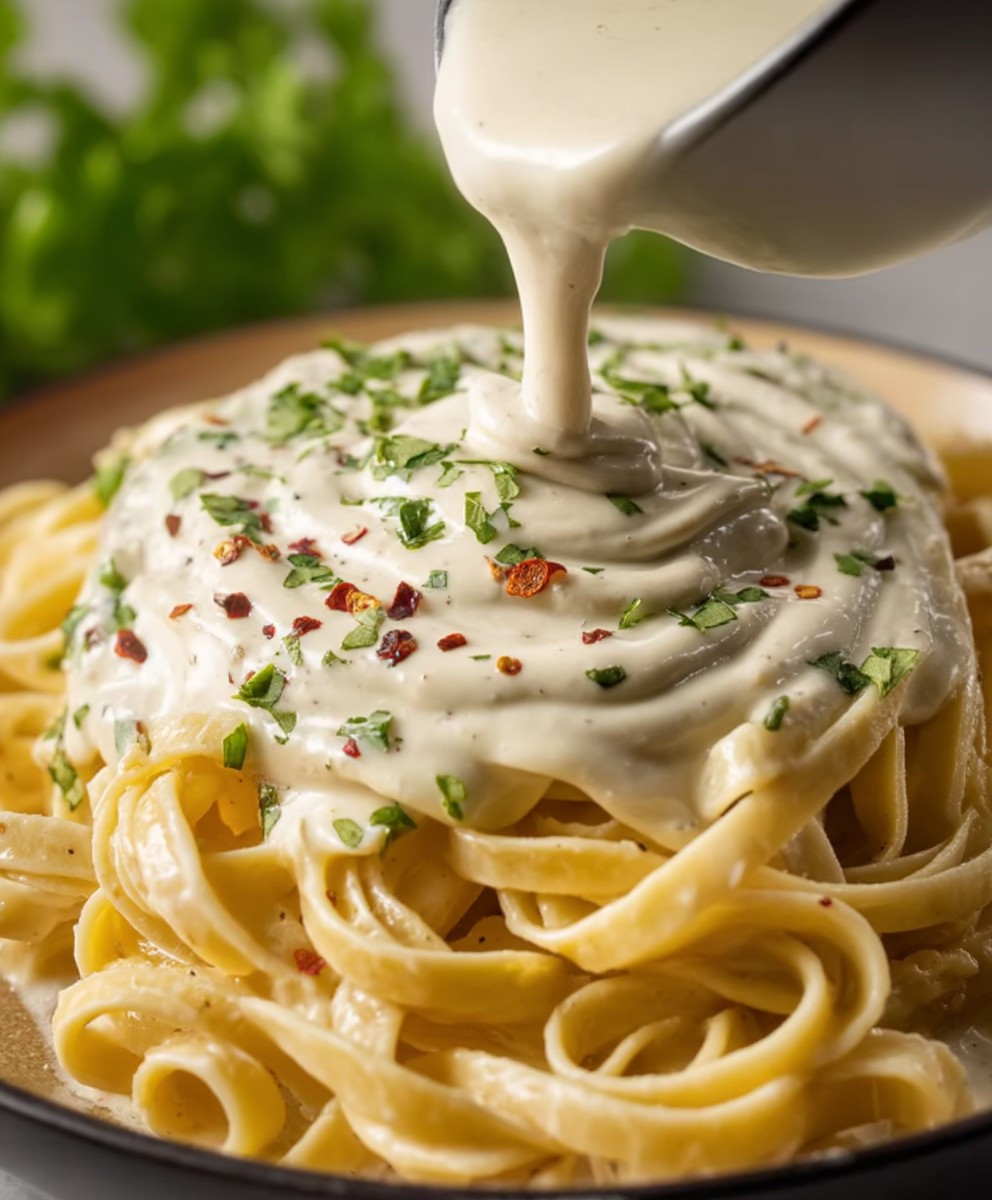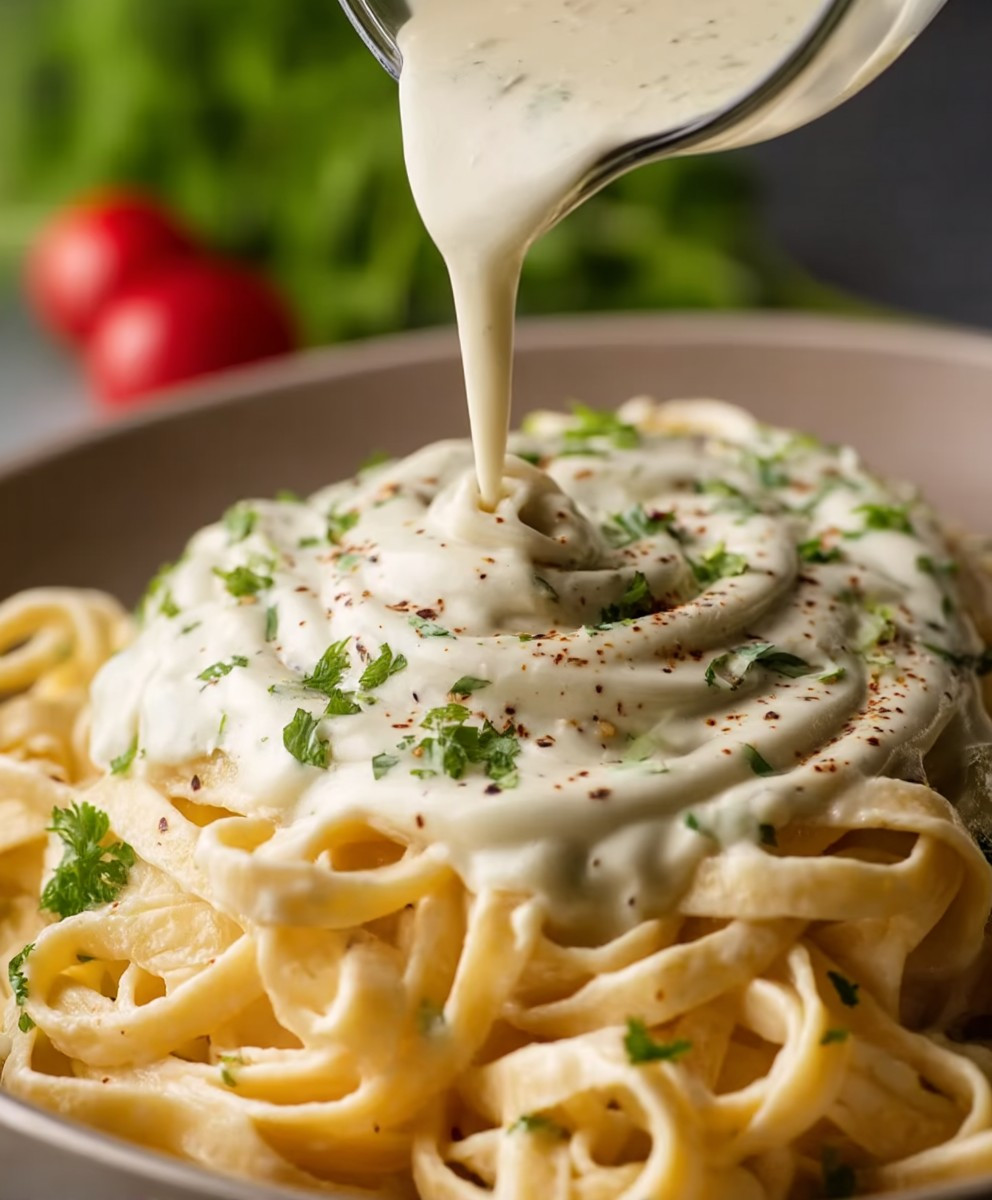Olive Garden Alfredo Sauce: the creamy, dreamy indulgence that has captivated taste buds for decades. Have you ever craved that rich, velvety sauce from Olive Garden but wished you could recreate it at home? Well, you’re in luck! This recipe brings the magic of Olive Garden right to your kitchen, allowing you to whip up a batch of authentic-tasting Alfredo whenever the craving strikes.
Alfredo sauce, while popularized in America by restaurants like Olive Garden, actually has humble beginnings in Rome, Italy. Created by Alfredo di Lelio in the early 20th century, the original recipe was a simple combination of butter, Parmesan cheese, and pasta water. Over time, the American version evolved, often incorporating heavy cream and other ingredients to achieve its signature richness.
People adore Olive Garden Alfredo Sauce for its luxurious texture and comforting flavor. It’s the perfect complement to fettuccine, chicken, shrimp, or even vegetables. Its versatility and ease of preparation make it a go-to dish for busy weeknights or elegant dinner parties. Get ready to impress your family and friends with this incredibly delicious and surprisingly simple recipe!
Ingredients:
- 1 cup (2 sticks) unsalted butter
- 1 pint heavy cream
- 1 ½ cups grated Parmesan cheese, plus more for serving
- ¼ teaspoon ground nutmeg
- ½ teaspoon garlic powder
- ½ teaspoon salt, or to taste
- ¼ teaspoon black pepper, or to taste
- Optional: 1/4 cup chopped fresh parsley, for garnish
Preparing the Alfredo Sauce:
- Melt the Butter: In a medium saucepan, melt the butter over medium-low heat. Be patient and let it melt slowly to prevent it from browning. Browning the butter will alter the flavor of the sauce, and we want that classic, creamy Alfredo taste. Keep a close eye on it!
- Add the Heavy Cream: Once the butter is completely melted, slowly pour in the heavy cream. Stir constantly to combine the butter and cream. This step is crucial for creating a smooth emulsion. If you add the cream too quickly, the butter might separate, resulting in a greasy sauce.
- Simmer Gently: Increase the heat slightly to medium, and bring the mixture to a gentle simmer. Do not let it boil! Boiling can cause the cream to curdle. Simmer for about 5-7 minutes, stirring occasionally, until the cream has slightly thickened. You’ll notice it coating the back of a spoon more easily.
- Incorporate the Parmesan Cheese: Reduce the heat to low. Now, it’s time for the star ingredient: Parmesan cheese! Add the grated Parmesan cheese gradually, about ½ cup at a time, stirring constantly until each addition is fully melted and incorporated into the sauce. This gradual addition helps prevent the cheese from clumping and ensures a smooth, velvety texture. Make sure you’re using freshly grated Parmesan for the best flavor and melting properties. Pre-shredded cheese often contains cellulose, which can hinder its ability to melt smoothly.
- Season the Sauce: Add the ground nutmeg, garlic powder, salt, and pepper. Stir well to combine. Taste the sauce and adjust the seasoning as needed. Remember, Parmesan cheese is already salty, so start with a smaller amount of salt and add more to your preference. The nutmeg adds a subtle warmth and depth of flavor that complements the richness of the cheese and cream.
- Maintain the Consistency: If the sauce becomes too thick, you can add a splash of milk or pasta water (if you’re serving it with pasta) to thin it out. If it’s too thin, continue simmering it over low heat, stirring occasionally, until it reaches your desired consistency. Keep in mind that the sauce will thicken slightly as it cools.
Tips for Success:
- Use High-Quality Ingredients: The quality of your ingredients will directly impact the flavor of the Alfredo sauce. Use good-quality butter, heavy cream, and, most importantly, freshly grated Parmesan cheese.
- Don’t Overcook the Sauce: Overcooking can cause the sauce to become grainy or separate. Keep the heat low and simmer gently.
- Stir Constantly: Constant stirring is essential for preventing the sauce from sticking to the bottom of the pan and ensuring a smooth, creamy texture.
- Adjust the Seasoning: Taste the sauce frequently and adjust the seasoning to your liking. Don’t be afraid to experiment with different herbs and spices. A pinch of red pepper flakes can add a nice kick!
- Serve Immediately: Alfredo sauce is best served immediately after it’s made. It tends to thicken as it cools, so have your pasta or other dishes ready to go.
Serving Suggestions:
Alfredo sauce is incredibly versatile and can be used in a variety of dishes. Here are a few of my favorite ways to serve it:
- Pasta Alfredo: This is the classic! Toss the Alfredo sauce with your favorite pasta, such as fettuccine, linguine, or penne. Garnish with extra Parmesan cheese and chopped parsley.
- Chicken Alfredo: Add grilled or pan-fried chicken to the pasta Alfredo for a complete and satisfying meal.
- Shrimp Alfredo: Sauté shrimp with garlic and butter, then toss it with the Alfredo sauce and pasta.
- Vegetable Alfredo: Add steamed or roasted vegetables, such as broccoli, asparagus, or mushrooms, to the pasta Alfredo for a vegetarian option.
- Alfredo Pizza: Use Alfredo sauce as a base for your pizza instead of tomato sauce. Top with your favorite toppings, such as chicken, spinach, and mushrooms.
- Alfredo Dip: Serve the Alfredo sauce as a dip with crusty bread, vegetables, or crackers.
- Alfredo Lasagna: Use Alfredo sauce in place of ricotta cheese in your lasagna for a richer, creamier flavor.
Variations:
Want to put your own spin on this classic Alfredo sauce? Here are a few variations to try:
- Garlic Alfredo: Increase the amount of garlic powder to 1 teaspoon or add 2-3 cloves of minced garlic to the butter while it’s melting.
- Lemon Alfredo: Add the zest and juice of ½ lemon to the sauce for a bright, citrusy flavor.
- Spicy Alfredo: Add a pinch of red pepper flakes or a dash of hot sauce to the sauce for a spicy kick.
- Mushroom Alfredo: Sauté sliced mushrooms in butter until softened, then add them to the sauce.
- Spinach Alfredo: Add a handful of fresh spinach to the sauce and cook until wilted.
- Sun-Dried Tomato Alfredo: Add chopped sun-dried tomatoes to the sauce for a tangy, savory flavor.
- Smoked Gouda Alfredo: Substitute some of the Parmesan cheese with smoked Gouda for a smoky, cheesy flavor.
Troubleshooting:
Sometimes, things don’t go exactly as planned in the kitchen. Here are a few common problems you might encounter when making Alfredo sauce and how to fix them:
- Sauce is too thick: Add a splash of milk, cream, or pasta water to thin it out.
- Sauce is too thin: Continue simmering it over low heat, stirring occasionally, until it thickens.
- Sauce is grainy: This can happen if the cheese is not melting properly. Try adding a tablespoon of butter and stirring vigorously. If that doesn’t work, you may need to strain the sauce through a fine-mesh sieve.
- Sauce is separating: This can happen if the sauce is overheated or if the butter and cream are not properly emulsified. Try whisking the sauce vigorously to bring it back together. If that doesn’t work, you may need to start over.
- Sauce is bland: Add more salt, pepper, garlic powder, or other seasonings to taste.
Make Ahead and Storage:
While Alfredo sauce is best served fresh, you can make it ahead of time and store it for later. Here’s how:
- Make Ahead: Prepare the sauce as directed, then let it cool completely. Store it in an airtight container in the refrigerator for up to 3 days.
- Reheating: Reheat the sauce gently over low heat, stirring occasionally, until it’s warmed through. You may need to add a splash of milk or cream to thin it out.
- Freezing: Freezing Alfredo sauce is not recommended, as it can change the texture and cause it to separate.
Nutritional Information (Approximate):
Please note that the nutritional information is an estimate and may vary depending on the specific ingredients used.
- Calories: Approximately 300-400 per serving
- Fat: 25-35 grams
- Saturated Fat: 15-20 grams
- Cholesterol: 100-150 mg
- Sodium: 300-400 mg
- Carbohydrates: 5-10 grams
- Protein: 10-15 grams
Enjoy your homemade Alfredo sauce! I hope you find this recipe helpful and delicious. Let me know in the comments if you have any questions or suggestions.
Conclusion:
This Olive Garden Alfredo Sauce recipe isn’t just another pasta sauce; it’s a creamy, dreamy experience that will transport you straight to Italy (or at least, your favorite Olive Garden!). The rich, velvety texture and the perfectly balanced flavors of garlic, Parmesan, and butter create a symphony in your mouth. Trust me, once you taste this homemade version, you’ll never reach for a jarred sauce again. It’s that good!
But why is this recipe a must-try? Well, beyond the incredible flavor, it’s surprisingly easy to make. You don’t need to be a culinary expert to whip up a batch of this luscious sauce. The ingredients are simple, the instructions are clear, and the result is restaurant-quality Alfredo right in your own kitchen. Plus, making it yourself means you control the ingredients, ensuring a fresh and delicious outcome every time. Forget the preservatives and artificial flavors – this is pure, unadulterated Alfredo goodness.
And the possibilities are endless! Of course, the classic pairing is with fettuccine, but don’t let that limit your creativity. Toss it with penne, linguine, or even tortellini for a delightful twist. For a heartier meal, add grilled chicken, shrimp, or vegetables like broccoli or asparagus. Imagine succulent grilled shrimp bathed in this creamy sauce, served over a bed of perfectly cooked pasta. Or picture tender chicken breast, sliced and nestled amongst fettuccine, all coated in the rich, garlicky Alfredo. My mouth is watering just thinking about it!
Looking for some variations? Try adding a pinch of red pepper flakes for a subtle kick. Or, for a more decadent experience, stir in a dollop of mascarpone cheese at the end. If you’re feeling adventurous, experiment with different types of cheese, like Asiago or Romano, to create your own signature Alfredo blend. You can even add a squeeze of lemon juice for a bright, citrusy note that cuts through the richness of the sauce.
Serving Suggestions:
* Classic Fettuccine Alfredo: The quintessential pairing for a reason!
* Chicken Alfredo: Add grilled or pan-fried chicken for a protein-packed meal.
* Shrimp Alfredo: A seafood lover’s dream come true.
* Vegetable Alfredo: Toss with your favorite veggies like broccoli, asparagus, or mushrooms.
* Alfredo Pizza: Use it as a base for a white pizza with your favorite toppings.
Variations to Explore:
* Spicy Alfredo: Add red pepper flakes for a touch of heat.
* Lemon Alfredo: A squeeze of lemon juice brightens the flavor.
* Mushroom Alfredo: Sautéed mushrooms add an earthy depth.
* Spinach Alfredo: Stir in fresh spinach for added nutrients and color.
* Smoked Gouda Alfredo: Substitute some of the Parmesan with smoked Gouda for a smoky flavor.
So, what are you waiting for? Grab your ingredients, put on your apron, and get ready to create some magic in the kitchen. This Olive Garden Alfredo Sauce recipe is a guaranteed crowd-pleaser, perfect for a weeknight dinner or a special occasion. I’m confident that you’ll love it as much as I do.
I can’t wait to hear about your experience! Did you try any of the variations? What did you serve it with? Share your photos and stories in the comments below. Let’s create a community of Alfredo aficionados! Happy cooking!
Olive Garden Alfredo Sauce: Recipe, Tips, and Secret Ingredients
Rich, creamy homemade Alfredo sauce for pasta, pizza, dips, and more! Made with butter, heavy cream, and Parmesan cheese.
Ingredients
Instructions
Recipe Notes
- Use high-quality ingredients for the best flavor.
- Don’t overcook the sauce; keep the heat low and simmer gently.
- Stir constantly to prevent sticking and ensure a smooth texture.
- Adjust the seasoning to your liking.
- Serve immediately after making.
- If the sauce becomes grainy, try adding a tablespoon of butter and stirring vigorously. If that doesn’t work, you may need to strain the sauce through a fine-mesh sieve.
- If the sauce is separating, try whisking the sauce vigorously to bring it back together. If that doesn’t work, you may need to start over.






Leave a Comment